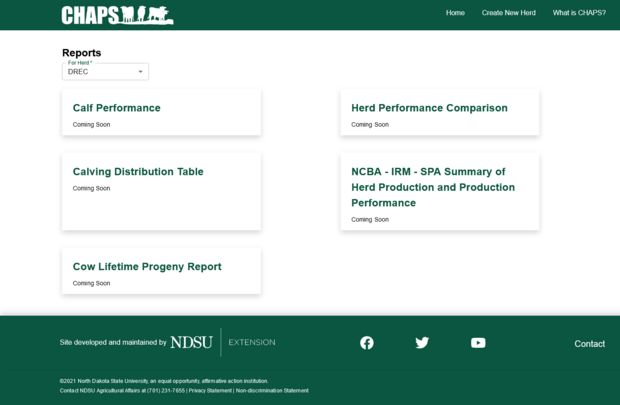Preview of CHAPS Online
The screenshots below provide a preview of the complete CHAPS online program.
The CHAPS home page has information about the CHAPS program, a sign-up portal for new users, and login button for existing users.

CHAPS users must create a new herd after creating a CHAPS account. CHAPS users can create multiple herds.

CHAPS users must create a new herd after creating a CHAPS account. CHAPS users can create multiple herds.

CHAPS users can access their active inventory listing a description of their herds and their total number of bulls.

CHAPS users can access individual herd inventories (cows and calves) as well as sires and bull turn out dates associated with herd. CHAPS users can enter periodic and annual events using the buttons on the right-hand side of the page.

CHAPS users can enter and save bull turn out dates (BTOD) including the bulls (Sire ID) associated with the BTOD.

CHAPS users can add bulls, identified by a Sire ID and sire breed, to their inventory. The source of the bulls (raised in the herd or purchased) must be identified as well as the use (natural service and artificial insemination).

CHAPS users can add cows, identified by a Cow ID and cow breed, to a herd. Cow birth date must be identified, as well as the source of the cow (raised in the herd or purchased).

CHAPS users can add a calf, identified by a Calf ID, to a herd. The calf birth circumstance (live birth, aborted/stillbirth, purchase), sire of calf and dam of calf must be entered as well as the calf birth date, sex of calf and calving ease. Uncommon situations, including creep feed, embryo transplant, twins and calves raised by a foster cow, may also be entered when adding a calf.

CHAPS users can wean a calf by checking the box to the left of the Calf ID. A weaning date must be entered. A sell box may be checked if the calf is being sold, weight can be entered as well as weight type (actual, estimated, pen average). Hip height and scrotal circumference my also be entered if measured.

CHAPS users can cull any animal (bull, cow, calf) from a herd by checking the box to the left of the animal ID, entering a culled date and culled reason, and selecting the save button. Multiple animal IDs may be selected to cull multiple animals on the same date for the same reason.

CHAPS users can create reports for their herd including calf performance and calving distribution as well as herd performance comparison, SPA herd production and performance, and cow lifetime progeny performance.

CHAPS users can access a brief history and description of the CHAPS program including links CHAPS publications providing more information.

A summary of calf performance including individual calf birth data, weaning data and dam/sire data. Additionally, herd averages for birth and weaning data are included as well as the previous year’s herd average, the 5-year herd rolling average and the 5-year CHAPS rolling average. The calf performance report also displays the number of calves born, died and sold.

The calving distribution table includes summaries of cows presently in the herd and leaving the herd (culled) since the previous bull turn out date. Cow data is presented by age of cow and includes the number of cows kept for calving, the number of cows aborted, open and calved, and the number of calves born each period. Additionally, the average birth date and wean weight for each age of cow is presented, followed by a listing cows yet to calve or open.

A summary of herd production and reproduction benchmarks for the current period, prior period and 5-year average. Additionally, the 5-year CHAPS benchmark is displayed for comparison to the herd.

A Standardized Performance Analysis (SPA) summary of herd reproduction and production performance measures, including calving distribution. 5-year CHAPS benchmarks are displayed for comparison to the herd.

A lifetime progeny report for each cow in the herd, including individual cow data with average calf performance data, and birth and weaning data for each calf born to the cow. CHAPS users may select active, culled or all cows in the herd for this report.



